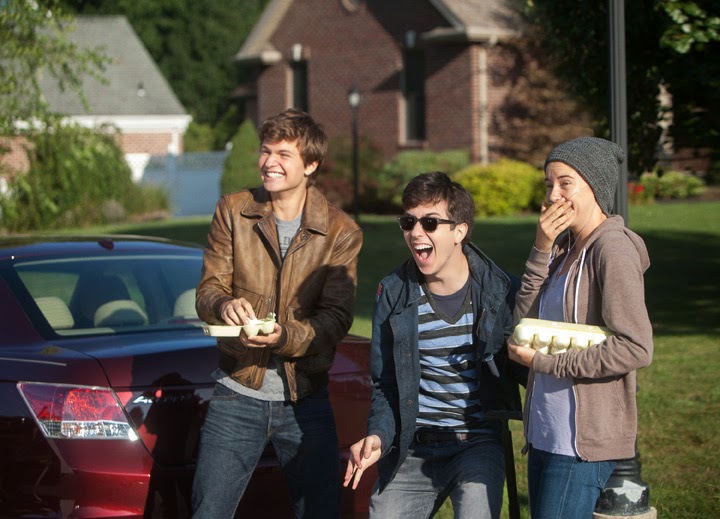Writes Dallas:
This isn’t just “a movie,” Hazel's voiceover intones over a close-up of Woodley's wonderfully expressive eyes, but a document of authentic lived experience that dares to stare terminal cancer baldly in the face rather than hide behind euphemisms and syrupy montages. A noble mission, to be sure, and one that shows the filmmakers have the right instincts about how to tell this story, but ultimately The Fault in Our Stars doesn't live up to these claims, as it takes few chances, frequently using sass as a smokescreen, hiding what's unoriginal and cheaply sentimental about this story behind a veil of witticisms about oblivion and "cancer perks."
Dallas believes the filmmakers use wit and sarcasm to distract from what is, at heart, a mawkish story. Some of his points ring truer than others, as when he calls the “improbably named” Augustus Waters “a somewhat impossible character, too High School Musical dreamy and far too optimistic considering his history.” Even in the novel on which Stars is based, where his backstory is related in, and therefore his character is rendered with, greater depth, Augustus is Dream Boy Par Excellence for roughly two-thirds of the tale. Dallas does laud actor Ansel Elgort’s chemistry with Woodley, but the reviewer falters in extending his praise: their courtship “gives the film neurotic energy to make up for the saccharine shadow cast by their illnesses.”
The fault in this statement lies in the writer’s broad decrial of illness. If Dallas had attributed the film’s saccharine quality to the fantastic characterization of Augustus – the way it fulfills adolescent fantasies of a hot, sensitive, vulnerable boy who’s super articulate and super into the books you recommend to him – and to his being the male equivalent of a desired type a la the “manic pixie dream girl” trope, well then, I might be more liable to agree: an improbable central character can make for a centrally improbable, overwrought, story. But individual character does not enter into the following issue Dallas takes with TFIOS: Its story is saccharine because of the “shadow cast by their illnesses.”
By failing to define what, specifically, about their illnesses makes Hazel and Augustus’ story saccharine, Dallas appears to write off illness itself as saccharine. He provides examples elsewhere, as he goes on to cite moments that contribute to the film’s cloying sensibility: “The remainder of their trip abroad is full of lessons learned and grand romantic gestures, ending on a mawkish note with a misjudged semi-climactic sequence combining two very dangerous thematic elements: strangers erupting into applause, and, um, the Anne Frank House.” The latter examples are offered to support his claim of mawkishness (and are kept appropriately vague, in order to avoid spoilers), but no such evidence is given, even vaguely, to bolster “the saccharine shadow cast by their illnesses.”
This nit-picky reading of Dallas’ review is important for the questions it raises regarding the depiction of illness. How should we talk about the ill? What kind of stories should we craft about them, for them, including them? If we put them at the center of a love story, is that love story inevitably rendered mawkish by virtue of their illness, because tragedy, in the guise of a heightened mortality, is implied and un-ignorable? In other words, can a love story about the ill, with the implied tragedy of illness ever present, ever exist free of the charge of audience manipulation?
Dallas acknowledges the filmmakers’ wish to make good on Hazel’s opening voiceover, to “stare terminal cancer baldly in the face rather than hide behind euphemisms and syrupy montages.” This was precisely the aim of John Green, author of TFIOS the novel. Green has said he wanted to write a story in which the ill are not seen as fundamentally “other.” His desire to make the ill like every (healthy) one else arguably informed his decision to endow both Augustus but especially Hazel with a hyper self-awareness, with the ability to comment on marginalization as they experienced it, their very wit and insight making marginalization out to be ridiculous. Dallas, however, feels this language, instead of serving the “noble mission” of truth-telling, obscures the truth by posing a distraction. Which, to us, poses yet another question: How should the ill be made to talk about their illness? I happen to enjoy Green’s dialogue, much of which has been ably adapted or preserved by screenwriters Michael H. Weber and Scott Neustadter, but do the fictionally ill have to show off their intelligence in order to be taken seriously? Or, to Dallas’ point, should they speak more prosaically in this effort to prove they’re just like us?
I don’t know. I know what I would like to say: “Of course it’s possible to write a love story about the ill that does not leave itself vulnerable to charges of over-sentimentality, mawkishness, audience-manipulation.” But illness is sad. It’s unfair. It’s often random, and that’s scary, and fear and sadness will make you cry. And where audiences cry, critics, of the professional or peanut-gallery persuasion, will cry over-sentimentalism. At the very least, and as Dallas himself says, those involved with The Fault in Our Stars tried to transcend poor precedents of the “euphemisms and syrupy montages” variety. Regardless of how one feels about the results, I would caution against speaking in a manner that, intentionally or otherwise, reinforces poor precedents of the sweeping generalizations variety.



No comments:
Post a Comment